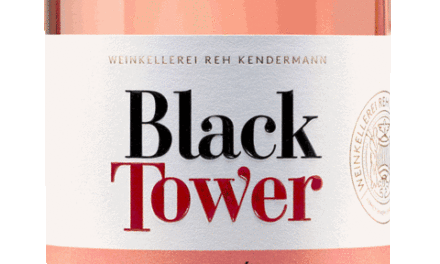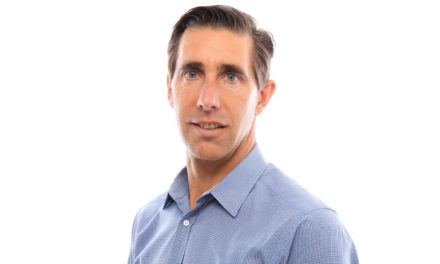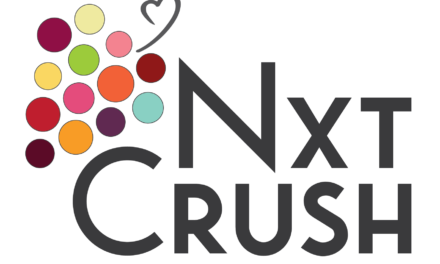We had the opportunity to connect with a diverse collection of winemakers, each passionate about chardonnay, opinionated about clones and winemaking techniques, and determined to show how distinctive the charonnays can be from this region.
One overarching takeaway: this is not the chardonnay you’re expecting—but perhaps it will become the chardonnay you prefer. Far from just “another” wanna-be California style of chardonnay, this is instead chardonnay with intent and focus. It tickles your cerebral cortex as much as it tickles your olfactories and engages your palate like a rafting trip on a wild river. Oregon is so much more than pinot noir and pinot gris.
Spirited asked several Willamette Valley winemakers a series of questions:
- Is there something inherent about the climate of the Willamette that naturally impacts the chardonnays that come from this region?
- Do you think there’s a “style” of chardonnay that some Willamette Valley winemakers have achieved or are trying to achieve?
- Have you personally changed the way you make chardonnay significantly in the last 5 to 10 years?
- Why do you, personally, make chardonnay?
- Is there a vintage you can point to that exemplifies your “ideal” snapshot of Willamette chardonnay?
- How would you like consumers to view chardonnay from the Willamette Valley in general?
Their answers are summarized below (the “where” indicates the subAVA within the larger Willamette Valley AVA, where their particular winery is located).
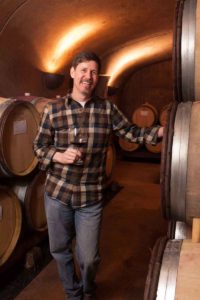
Alloro winemaker Tom Fitzpatrick [Photo courtesy Alloro Vineyards]
Where: Chehalem Mountains
Who: General manager/winemaker Tom Fitzpatrick
Experience: With a master’s degree in viticulture and enology from UC Davis, Fitzpatrick has passionately pursued winemaking in Burgundy, New Zealand, Napa, and the Willamette Valley, looking to express site with finesse, aromatics, and vibrancy.
Climate: Delivers chardonnay with lower sugar accumulation (and thus lower alcohol), better retention of acid, and a fruit profile that includes things like fresh apples, pear, citrus, and mineral flavors
Style: Bright acidity, slightly lower alcohol, and a fruit profile of apple, pear, citrus, and mineral (like the chardonnay from some other cool climates). However, Willamette chardonnay, when compared to some of these other Cool Climates, is more full, round, and rich.
Winemaking: Nothing significant, but I continue to experiment with canopy management and crop load in the vineyard, fermentation temperature and management, and different cooperages.
Why Chard? It’s a personal quest. There is certainly an interest in Oregon chardonnay among wine trade, however I would still characterize consumer demand as low and specific to particular segments.
Ideal Vintage: Vintages 2010 and 2019, marked by moderate temps during ripening.
Consumer Takeaway: As being world class and as good as the great world class chardonnays from other places, but having a profile that is all its own and uniquely “Willamette Valley.”
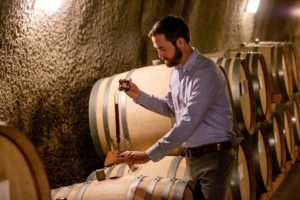
Winemaker Ian Burch [Photo courtesy Archery Summit]
Where: Dundee Hills
Who: Ian Burch
Experience: With a wine education degree from Cal Poly, Burch headed to France where he fell in love with winemaking in the Loire, and pinot noir and chardonnay in Burgundy. At Evening Land (Oregon), he met famed Burgundian winemaker Dominique Lafon, whom he considers among his greatest mentors.
Climate: Since the Willamette frequently gets cool nights due to a strong costal marine influence and a relatively dry growing season, with wet winters, the Willamette is perfect for chardonnay.
Style: I think that there is a general trend towards making Oregon chardonnays that are leaner, with lower alcohol and higher acid.
Winemaking: Getting the fruit pick right sets the stage for everything else. I look for seeds browning, a nice acid/sugar ratio and aim for a potential alcohol of around 13% when I can, to show the vineyard site without excessive alcohol and a soapy texture. Making wine in Burgundy for a few harvests alongside Dominique Lafon and Christophe Vial taught me to approach chardonnay on an incredible site in Meursault or Puligny the same way I did a site in Dundee or Eola-Amity: bringing out the visible heart and soul of the place.
Why Chard? I love Oregon chardonnay. I am especially fond of Chardonnay grown on basalt but personally love drinking and making it. I am trying to build more of a presence for chardonnay at Archery Summit, which has largely been a pinot noir producer for 27 years. Chardonnay has a lot to say and as incredible as an Oregon pinot noir can be, chardonnay can be stunning.
Ideal Vintage: 2007. There is an angularity to the wines and my first, true perception of what the grape could actually do in Oregon. They are aging beautifully.
Consumer Takeaway: I want people to think about Oregon chardonnay as much as they think about pinot noir. I want people to say “Oregon Chardonnay” like they say Chablis or Champagne. Like there is an innate sense that Oregon chardonnay is refreshing, full of life and delicious.
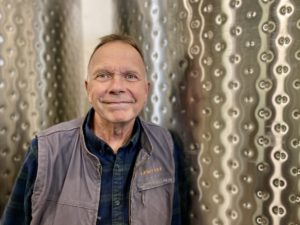
Winemaker Wayne Bailey [Photo courtesy Bailey Family Vineyards]
Where: McMinnville, AVA
Who: Wayne Bailey, owner/winemaker
Experience: Determined to raise his three young daughters on a sustainable and responsible farm, Iowan Wayne Bailey and his wife Nicollette, moved to Youngberg Hill in 2003. Backgrounds in the wine business guided them towards a successful winery with two labels, a destination inn and a new label, Bailey Family, by allocation only.
Climate: While chardonnay can be grown almost anywhere, it is best grown in climate conditions similar to those most suitable for pinot noir. We are ripening in September and October, which means that we are ripening fruit to maturity in cooler weather, which provides us fruit that is more elegant, more balanced, less volume/weight, and brighter fruit characteristics.
Style: We are producing chardonnay with intention that it will age as well as white Burgundy. As a result, there is also the distinction of less aggressive oak treatment. We are trying to maintain the fresh fruit characteristics that will age beautifully in the cellar.
Winemaking: I have from the beginning aspired to make chardonnay with the same cellar aging potential as I experienced in Burgundy. Instead of looking at Brix or acids, I look at seeds, skins, pulp density, and fruit characteristics.
Why Chard? Certainly my own desire to produce chardonnay in a similar style to what I fell in love with in Burgundy, but I also see a change in consumer palates that are tiring of over-oaked chardonnays.
Ideal Vintage: Cooler vintages like 2007 and 2010 stand out for me. And I really like 2017.
Consumer Takeaway: As a well-balanced, fruit-driven, elegant style of chardonnay where the drinker enjoys the next sip more than the last and at the end says, “I can’t wait to taste this in 20 years.”
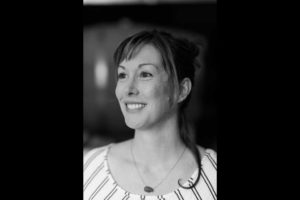
Winemaker Rachel Rose [Photo courtesy Bryn Mawr Vineyards]
Where: Eola-Amity Hills
Who: Rachel Rose, Winemaker & Vineyard Director, since 2010
Experience: Following a B.S in Molecular, Cellular, and Developmental Biology from the UC Santa Cruz, a career in biotech seemed inevitable, but it was love of food and travel that led her to study viticulture in Australia. Here Rachel discovered Burgundian varietals, and thought Oregon might be the new promised land.
Climate: We have extended hours of daylight due to our latitude. I believe these seasonal swings contribute to the character and quality of the wines. I think we have the ability to grow grapes with great aromatic intensity and texture due to the midseason warmth and sunlight, while the cool harvest conditions allow us retain freshness and verve in the wines.
Style: The most unifying style I have observed in the Willamette Valley is the judicious use of oak and the modest levels of alcohol. I don’t know of many producers in the “Valley” who are going for the super ripe, rich, and oaky style of chardonnay.
Winemaking: Definitely. In 2014, I began using large format 500L puncheons for all of my chardonnay barrel fermentations and aging; prior to that, I used smaller 288L barriques. I love how the larger format barrels retain delicate aromatics and verve while still allowing the texture to evolve. I have also moved to making most of my upper tier chardonnay in a reductive fashion, to showcase the primary fruit aromatics and preserve glutathione, which is a natural anti-oxidant that gives the wine protection without the use of sulfur.
Why Chard? Chardonnay grapes grow beautifully in the Willamette Valley. We can grow grapes that make wines with complex aromatics and fantastic energy.
Ideal Vintage: No. Each vintage is unique, and I’m okay with that. I love the fact that every wine can tell the story of its growing season if allowed. I’m a farmer at heart, and I embrace vintage variation.
Consumer Takeaway: I think that most consumers shy away from chardonnay because they think it is going to be heavy and over-oaked. I would like consumers to know that chardonnay from the Willamette Valley is typically more fresh, vibrant, and aromatically elegant.
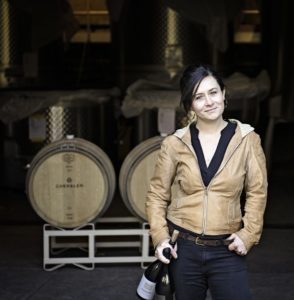
Winemaker Katie Santora [Photo courtesy Chehalem]
Where: Chehalem Mountains
Who: Katie Santora
Experience: A Utah native, Katie fell in love with wine at UC Davis, where she traveled the world after receiving her enology and viticulture degree. Oregon’s exceptional terroir for wine and adventure called to her. She joined Chehalem in 2012 as assistant winemaker, and was promoted to winemaker in 2018.
Climate: The original clones of chardonnay planted did not match the cool climate of the valley, and Willamette Valley chardonnay had a hard time finding its style. Different clones more adaptable to a cooler climate were planted, bringing more balance and a more consistent chardonnay emerging.
Style: Our style is somewhere in between Chablis and California. It has a richness that is balanced with bright acid and a mineralistic backbone.
Winemaking: We make two styles: unoaked (INOX) and barrel-fermented (reserve). I have tightened up our techniques to highlight each aspect and style further. This work starts in the vineyard before it moves to the cellar. We crop a little heavier for INOX and go through slow temperature-controlled fermentation. For our Reserve Chardonnay, we thin the crop a bit more to achieve more flavor and balance.
Why Chard? I LOVE it! It’s 100% a personal quest. On top of that, I want to help consumers let go of their preconceived notions about chardonnay and love it as much as I do.
Ideal Vintage: I do love how the 2011 chardonnays are aging. It was the latest vintage on record, and the acid retention in those wines is carrying them for the long haul.
Consumer Takeaway: I want consumers to see that chardonnays in the Willamette Valley are their own thing. Serious and delicious. They are starting to get the attention they deserve, and I don’t think this momentum is going to slow down.
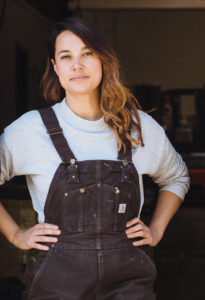
Kate Norris, co-winemaker [Photo courtesy Division Wine Company]
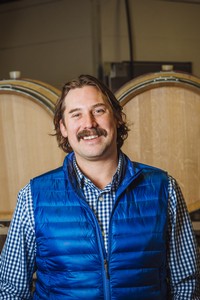
Tom Monroe, co-winemaker [Photo courtesy Division Wine Company]
Where: Willamette Valley
Who: Kate Norris and Tom Monroe are co-owners & co-winemakers of Division Winemaking Company, founded in 2010.
Experience: Kate hails from Bahrain and has lived in England, Switzerland, France and the U.S. Tom, a Missouri native, left financial services for winemaking. Both have experience in the Loire Valley, Beaujolais and Burgundy regions. They moved to OR in 2010.
Climate: The Willamette and Burgundy share the 45th degree of Latitude (North to South), which means that the amount of daylight and potential sun exposure to the vines are very similar. The Willamette has 1250 average growing degrees vs. about 1300 in Burgundy. The large diurnal shift we experience during the warmest parts of the summer (July and August) that keeps the natural acidity in the grapes quite high and the relatively low humidity during these months that reduce disease pressures.
Style: More and more winemakers (especially the younger wineries) are choosing the more reductive approach, which is also more popular now in Burgundy. We utilize both the oxidative and reductive techniques, based on which approach has worked better for a specific vineyard site. Generalizing, Napa style chardonnay is more lush and full bodied, while Chablis style is more lean and nervy: the Willamette tends to land somewhere more in the middle and is typically medium bodied with fair to high acidity.
Winemaking: As we’ve gained experience with our different vineyard sites, we’ve tried different approaches and have mostly chosen to stick with what makes the most interesting wine for the site. We had very little experience with reductive winemaking before 2014, when we tried the approach with one lot of Biodynamic farmed old vine chardonnay from Cooper Mountain Vineyards. That approach has really worked well for a few of our vineyards, while the more oxidative/traditional method is still preferred for others.
Why Chard? Definitely a personal quest. When we started making chardonnay, the wine world clearly didn’t need another chardonnay – it still doesn’t! It’s easily one of our top 3 white grapes and because the climate is so well suited for it here, we knew we couldn’t resist trying our hand. Thankfully, the interest in Oregon Chardonnay has really increased or we might not still be making it.
Ideal Vintage: The overall cooler years (2010, 2011 & 2019) and the years when it was warm during the first half of the growing seasons, but cooler after veraison (2013 & 2018).
Consumer Takeaway: That the region has the capacity to make truly world class chardonnay and that the value of the chardonnays made from the Willamette Valley is extraordinarily high in comparison to cost of many Californian and Burgundian style chardonnays.
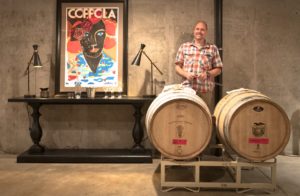
Winemaker Dave Petterson [Photo courtesy Domaine de Broglie]
Where: Dundee Hills
Who: Dave Petterson, GM/Winemaker
Experience: Born in PA, Petterson studied geography and geology at Vassar College, then moved to Portland to pursue an MS in Cartography GIS. He married into wine, as his wife’s family owned Panther Creek Cellars, where he became assistant winemaker in 2003. He then became GM/AW at Vista Hills in 2007, which was purchased by Francis Ford Coppola in 2018 and renamed in honor of Nobel prize-winning Louis de Broglie, a nobleman from Maison de Broglie, a French powerhouse that made many contributions in physics and quantum theory.
Climate: Cooler weather leads to retention of acidity and slows development of sugar. Less sugar means less ethanol in the finished wine. Ethanol and sweet fruit flavor have a tendency to overwhelm subtler mineral flavors. Willamette Valley chardonnays are at their best when the crispness of acidity, minerality and fresh fruit show.
Style: I was brought up in a tradition of Oregon winemaking where the style is driven by the vineyard and the vintage, and the wine is made to be clean, straightforward, and expressive. I’m sure there are innumerable different stylistic approaches to chard in the Willamette Valley.
Winemaking: Making chardonnay is new to me. The 2018 chardonnay is the first produced from vines grafted over from pinot gris in 2016 here at Domaine De Broglie.
Why Chard? Both. This vineyard was planted with way too much Pinot Gris, which at the time of planting was the most popular white wine in Oregon and was considered a relatively “safe” choice at a cool high elevation site. I like the Pinot Gris we have grown and made up here since 1998, but also felt like it was a limited wine. I started thinking about grafting some of the pinot gris to chardonnay as early as 2014 because I was confident that our customers would welcome it but also because I thought it would be interesting to see how it differed from the pinot gris.
Ideal Vintage: Too new to me to say much about this, but I got awfully lucky with my first vintage. My chardonnay was also extra slow ripening because of being fairly newly grafted. I will be interested to see how this 2018 stacks up in the long run.
Consumer Takeaway: I would hope they see Willamette Valley chardonnays as adventurous, diverse and expressive of time, place, and the person who made them.

Winemaker Joe Wright [Photo courtesy Left Coast Cellars]
Where: Willamette Valley
Who: Winemaker Joe Wright, with Left Coast since 2011
Experience: Over 24 years of making chardonnay in Oregon, including Willamette Valley Vineyards, Griffin Creek, Tualatin Estate, and Belle Vallée Cellar.
Climate: Longer hang time coupled with moderate temperatures resulting in physiologically ripe yet restrained wines that can lean stylistically towards brightly-energized, focused yet rich, age worthy Oregon chardonnay.
Style: Possibly one of age-worthiness: having followed Oregon chardonnay for the last 24 years, it hasn’t always been the case. Understanding how to grow for physiological ripeness an overall balance at lower sugars is key to this.
Winemaking: In the vineyard, early west facing basal leaf removal regrows with half its original surface area for a perfect blend of sun and shade which seems to achieve overall ripeness and still retains ample acidity.
In the winery, 100% new oak barrel fermentations / 500 ltr puncheons / all lightly toasted. All new oak but much less surface area and very lightly toasted barrels seem to help retain focus, freshness and add body to the wine without being overly assertive.
Why Chard? It’s my absolute favorite white wine. Like pinot noir, it’s an incredibly transparent varietal with regard to the ground it’s grown on, the micro-climate it grows within, elevations and vine age. To create age-worthy chardonnay that can be enjoyed for generations keeps me coming back vintage after vintage.
Ideal Vintage: 2010. Naturally lower yields and a long extended moderately tempered fall. Incredible concentration and depth acquired with no regard to lower sugars at harvest. Great purity! Am drinking my 2010 chards currently.
Consumer Takeaway: As small lot production chardonnay cared for by individuals and families. Grown in the cool Pacific Northwest resulting in bright, focused, flavorful, food-friendly wine. How can one go wrong?

Winemaker Steve Lutz [Photo courtesy Lenne Estate]
Where: Yamhill-Carlton
Who: Steve Lutz, winemaker
Experience: Fled corporate life for winemaking in Napa, including stints at Beringer, Merryvale, Inglenook, then headed north to Chateau Benoit and Anne Amie in Oregon. Planted Lenné in 2001.
Climate: Certainly the cooler weather, so proper clones are important.
Style: I think many are trying to look to Burgundy and picking less ripe and wrapping the wines in lots of new oak, which isn’t our style.
Winemaking: We have only been making chardonnay since 2016 and even though the wines I described above are getting good scores, I don’t like them so we make it in a style we like. The means starting with a very clean juice without any phenolic presence, picking in the mid-end of the ripening spectrum. We try to get the pear aromatic in our chardonnays. Finally we ferment and age them in puncheons to impart the texture with out phenolics and heavy-handed oak aromatics.
Why Chard? A little of both.
Ideal Vintage: Not really as we have primarily had warm vintages since we have been making chardonnay and we are interested in seeing what happens in a cooler vintage.
Consumer Takeaway: I think they are slowly understanding that we can make some of the best chardonnay’s in the world. Originally the wrong clone was planted here which probably set back consumers perceptions but there is no denying that we are making some extraordinary chardonnays today and consumers are starting to recognize that.
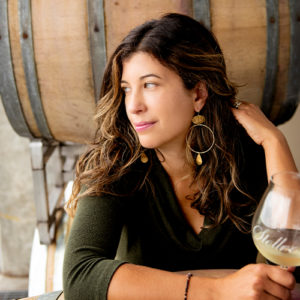
Winemaker Melissa Burr [Photo courtesy Stollar Family Estate]
Where: Dundee Hills
Who: Melissa Burr, VP of Winemaking
Experience: Burr, a native Oregonian, studied neuropathic medicine before discovering her passion for winemaking. After studying fermentation science at OSU, she became production winemaker for Cooper Mountain and joined Stoller in 2003.
Climate: Chardonnay in our region can capture stone fruit and citrus notes from this climate (and our soils), which don’t always show in warmer regions.
Style: Chardonnay is such a transparent, mutable wine to make. I think the Willamette Valley is getting to its style, and I believe it is all about elegance, acidity, and texture.
Winemaking: Yes. I would pick when the fruit tasted very concentrated, and the skins were golden. I also would ferment and go through full malo in barrel. Now, I adjust per vintage the amount of malo, usually only partial, and I pick a lot earlier. It seems when the fruit tastes perfect in the vineyard, it’s over the fresh point when it turns to wine. I like to avoid green/grassy flavors, so I am trying to find the balance of when we hit that point
Why Chard? I love to drink it and appreciate how many styles of wine can be made with the variety.
Ideal Vintage: The 2010 vintage was so cool in heat units that we started harvesting an entire month late; however, the wines are beautiful, aromatic, delicate yet intense. It was one of my favorite chardonnay vintages. The 2019 whites across the board are looking similar. (Spoiler alert: the 2019 Stoller chard is phenomenal)
Consumer Takeaway: I want consumers to see that chardonnays in the Willamette Valley are their own thing. Serious and delicious. They are starting to get the attention they deserve, and I don’t think this momentum is going to slow down.
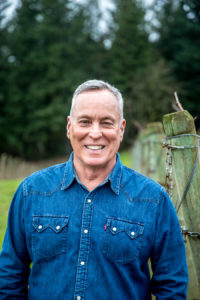
Winemaker Dan Warnshuis [Photo courtesy Utopia]
Where: Ribbon Ridge AVA
Who: Dan Warnshuis
Experience: After a high tech career in CA, where he got involved with wine, Dan found the perfect place to grow pinot in the Willamette Valley, and called it Utopia.
Climate: Cooler temperatures lead to more gradual ripening which in turn results in more balanced and complex fruit.
Style: Willamette Valley chardonnay comes in a variety of styles including the best of both Old World (high acid and minimal or no oak influence) and New World (heavily oaked, buttery and viscous). The best Willamette Valley chardonnay’s are in between the Old and New World style and like our best pinot noir’s, they utilize the Dijon clones and express the individual site characteristics and sense of place that is uniquely Oregon.
Winemaking: Harvesting a little under ripe to preserve the natural acid in the grapes, whole cluster press and barrel fermentation with minimal oak impact for a light but focused application of new French oak.
Why Chard? I love good chardonnay and the challenge it presents as winemaker to do it well.
Ideal Vintage: 2012 as a vintage for Willamette Valley chardonnay was excellent. For me personally, it was my 2013 Estate chardonnay.
Consumer Takeaway: The best of what chardonnay can offer in a variety of styles to suit any consumer preference. Certainly, in most recent vintages with more terroir driven chardonnay, the trend in Willamette Valley is towards a lighter, more acid driven, with bright tropical fruit and citrus aromas and flavors coupled with light creamy textures vs. the bigger, buttery, oak and MLF influenced style that California made famous.
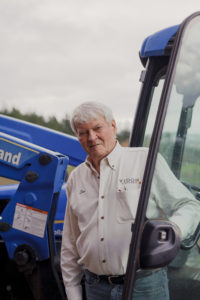
Winemaker Don Hagge [Photo courtesy Vidon Vineyards]
Where: Chehalem Mountains
Who: Owner, Don Hagge, planted the vineyard in 1999, and still makes wine, although Dave Bellows made the 2017 Vidon chardonnay reviewed here.
Experience: A bona fide rocket scientist, who actually worked at NASA for three decades, designing instrumentation for satellites, including the Explorer series, Hagge hails from North Dakota and lived in France while doing post grad physics research. As Chief Physicist for NASA Apollo missions 7—13, he lived in Silicon Valley, until he “retired” at 69 and moved with wife, Vicki, to OR, to plant a vineyard. It combines his love of farming and of Burgundy. He’s a man of few words.
Climate: Yes, the cool, maritime climate preserves acidity in most areas.
Style: Better acids and more minerality, more in the Chablis direction.
Winemaking: Use more neutral oak and less steel
Why Chard? Both.
Ideal Vintage: 2015
Consumer Takeaway: Not big and buttery; fresh with nice acids and minerality.
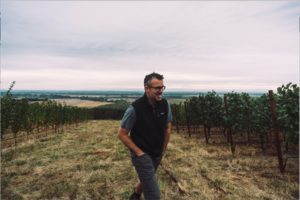
Winemaker Ken Pahlow [Photo courtesy Walter Scott Wines]
Where: Eola-Amity Hills
Who: Ken Pahlow, Winemaker
Experience: Ken and his wife, Erica Landon, founded Walter Scott in 2008 to honor two people important to Ken: Walter, his grandfather, a flight engineer for Trans World Airlines, who lived a bold and courageous life, and Scott, Ken’s nephew, who left life too soon. They crushed at Evening Land prior to moving to their current location.
Climate: Even in the hottest vintages (2014 & 2015), we are still one of the coolest regions growing chardonnay which allows us to retain natural acidity all while achieving optimum ripeness levels and flavor development.
Style: We don’t believe there is a defining Willamette Valley ‘style’ at this point. The Walter Scott style is to show off what we feel are the beautiful characteristics of Willamette Valley chardonnay, which are intense, richly texture wines with complex flavors, tension, minerality and electric acidity.
Winemaking: The most significant changes and experiments have been with farming practices. In 2018, early in the growing season, we set out to determine our vine’s crop load, thus determining the volume of grapes we would harvest from each acre at the time of picking. We aggressively removed shoots from the vine to decrease the crop load, with the goal being fully ripened fruit with higher natural acidity, low PH and intensity of flavor without excess sugar. What we achieved with our growers in 2018 has set the stage for how we will farm our vineyards from now on.
Why Chard? Personal quest drives our desire to make chardonnay and demand has allowed us to continue to increase our production and work with amazing sites. We love the varietal. It is one of, if not the greatest translators of place, and here in the Willamette Valley, we have an incredible terroir to translate.
Ideal Vintage: 2018, our 10th anniversary harvest. We believe we found our groove with chardonnay and set the tone for years to come.
Consumer Takeaway: It is our goal and belief that chardonnay from the Willamette Valley will be viewed as one of the great white wines of the world.
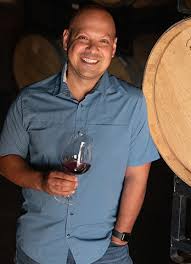
Winemaker Joel Ibrahim [Photo courtesy Willamette Valley Vineyards]
Where: Willamette Valley
Who: Joe Ibrahim, Head Winemaker
Experience: A native New Yorker, it was a home winemaking kit that got Joe trying his hand at dandelion and turnip wine (admittedly just awful). This led him to study Plant Science in Vermont, and winemaking stints in Lake Champlain and California (Gallo, Edna Valley Vineyards) eventually brought him to Oregon.
Climate: Growing chardonnay in this climate provides flavor expression in the citrus, pome fruit (pear, apple and quince) and melon range, and less in the tropical fruit range that you can find hard to avoid in warm, faster ripening climates.
Style: I don’t think there is a “style” winemakers are trying to achieve. Chardonnay can be shaped and styled in ways other varieties can’t, and almost in a way, enjoys being shaped by the winemaker. I think you could find common threads of styles in Willamette Valley produced chardonnays dictated by growing conditions, clones, and vintage conditions. However, for those producers who are passionate for the variety, as we are, you will find unique characteristics driven by honed experience and elements of a house style, that you may not find outside of those producers.
Winemaking: One of my most significant changes has been the way we address mouthfeel and the use of malolactic fermentation to achieve balance. We now address each individual barrel rather than the whole lot the same way. That means we taste each barrel through fermentation and aging and dial in whether we will not conduct malolactic fermentation at all, or to arrest the fermentation part way through or to complete the secondary fermentation. We find this gives us the most complex and balanced wines. We are constantly asking the barrels ” what do you want to be?”
Why Chard? We are very passionate about the variety. One of the draws to Willamette Valley Vineyards was the rich history with Dijon Clones of Chardonnay. We have this amazing planting of chardonnay at our main Estate Vineyard, grown on Geneva Double Curtain trellis (which has these beautiful waterfall pendulous style of growing the vine canes) that produces amazing fruit and wine that just gets me so excited each season watching it grow, ripen and develop in the cellar. We also have original 1973 plantings from Oregon Wine Pioneer, Bill Fuller of Tualatin Vineyards of the Draper Clone of chardonnay he brought up from California. Now, with warmer seasons each year, these clones perform exceptionally well.
Ideal Vintage: I’ve been raving about the 2018 vintage. This was a 1 in 100 vintage years in the Willamette, with no risk of rain during harvest and beautiful ripening weather.
Consumer Takeaway: I’m actually surprised it hasn’t connected more broadly with the consumer yet, but that is maybe because until recently there just weren’t that many acres dedicated to chardonnay in the Willamette Valley. I’m glad that has changed. One of the most regular comments I get when I’m on the road sharing our wines is, “I don’t like buttery and oaky chardonnays.” Willamette Valley chardonnays tend to be the complete opposite; fresh, textural, lively and captivating. It is fun to change people’s opinion of the varietal.












































